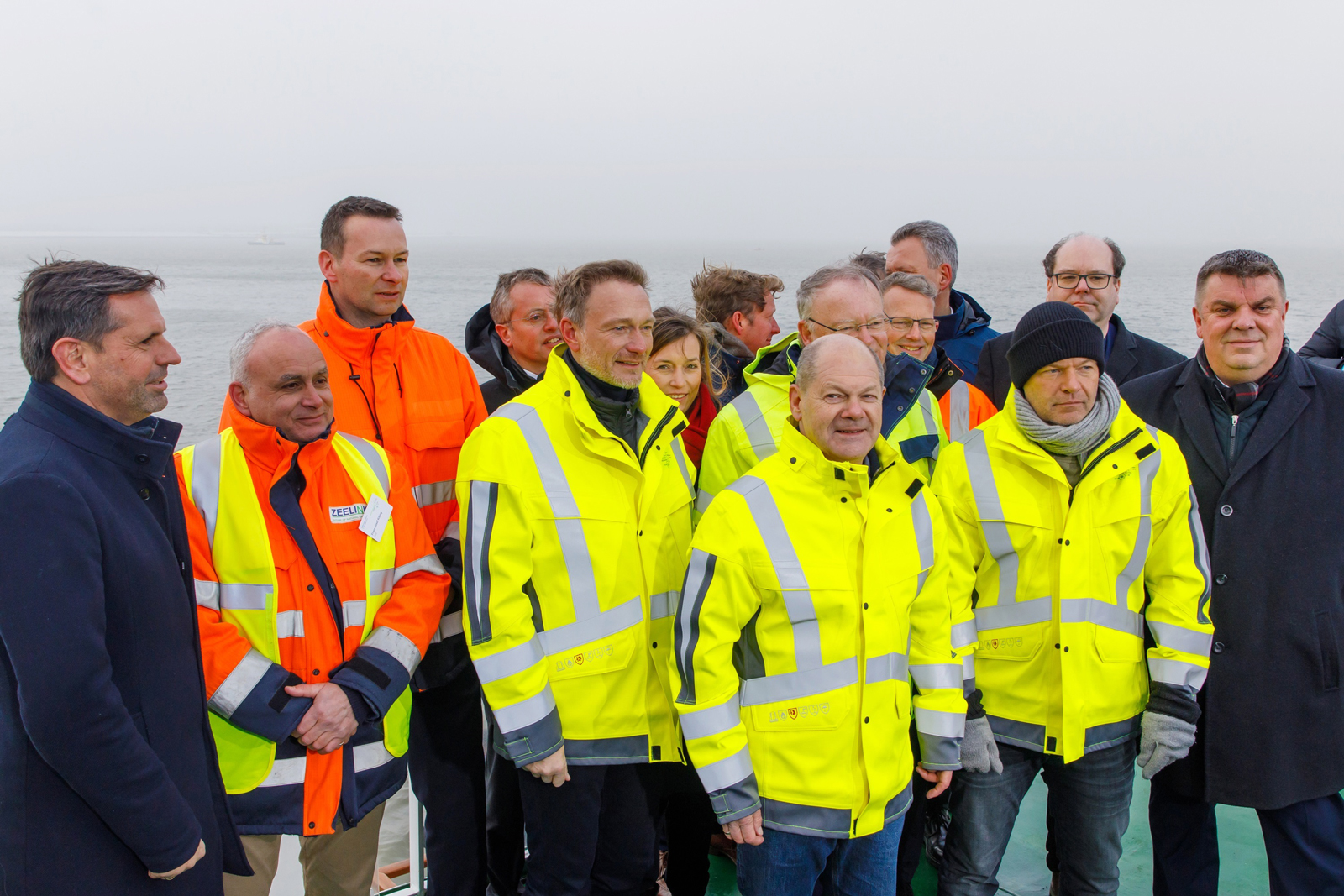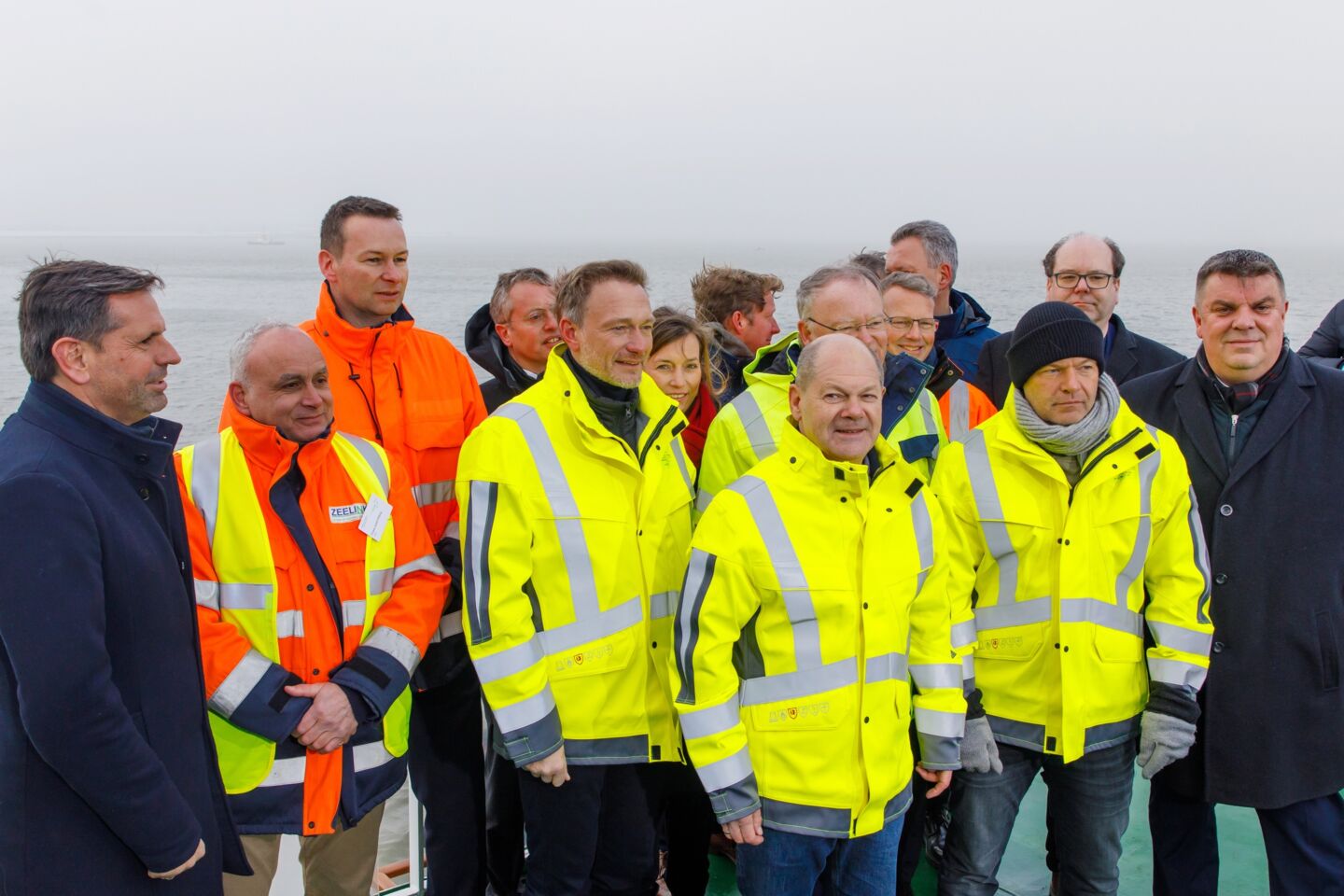Broad Political Interest
German Chancellor Olaf Scholz, Niedersachsen's Prime Minister Stephan Weil, German Minister for Economic Affairs Robert Habeck, and the Federal Minister of Finance Christian Lindner are on site, attending the official opening. Niedersachsen's Minister for Economic Affairs, Olaf Lies, Minister for Environment and Energy, Christian Meyer, and additional representatives of the state, the city, and regional communities are also in attendance. During the past ten months, the three companies Niedersachsen Ports, OGE, and Uniper worked hand in hand, and in record time they created the infrastructure on the North Sea shore in the shape of the Import Terminal and the Wilhelmshaven Connector Pipeline (WAL) and are now welcoming the companies’ project teams aboard the LNG ferry MS “Helgoland”.
Hand in Hand Towards a Common Goal
The short stretch of time since March of 2022 entailed some important steps: The preparation of numerous approval documents in the spring, start of construction with the first pile-driver blow on May 5, chartering the FSRU in July, start of construction work and laying pipes for the connection pipeline in August, handover of the completed port jetty in November, the connection of the WAL to the long-distance gas grid, and the on-time arrival of MV “Höegh Esperanza” are only a few examples.
Background:
Barely ten months ago, the German government had set the new course for the energy supply in order to strengthen the energy security as early as this winter and to diversify their gas sourcing. The implementation was only made possible through tight collaboration between politics, authorities, and companies.
The first import terminal for LNG in Germany was realized in Wilhelmshaven at the Cargo Handling Facility Vosslapper Groden (UVG). At the request of the Federal Republic of Germany, Uniper will be operating the terminal. The FSRU was chartered and made available by the Federal Republic of Germany. Within the context of supply security, Germany is benefiting from the diversification of the sources and from the avoidance of one-sided dependencies: LNG can be sourced from new suppliers and thereby contribute to the supply security. It is Uniper's goal to strengthen Germany's supply security and to pave the way towards a sustainable energy future. The design of the LNG Terminal and pipelines was planned in a ‘hydrogen-ready’ way, thus enabling synergies for the move towards a CO2-neutral energy economy.
The location Wilhelmshaven offers ideal conditions, both, from a maritime and from a logistic point of view. LNG tankships of all sizes will be able to call the facility, regardless of the tides and in compliance with the highest international safety standards. For the connection to the existing LNG long-distance grid, a gas pipeline with a total length of 26 kilometers was constructed, the implementation of which was accomplished by the company OGE.
At the floating LNG Terminal, the LNG that is delivered by a tankship is conveyed onto the FSRU. There, it is vapor-ized, thus converting it back to a gaseous state. Subsequently, the gas is fed via the Wilhelmshaven Connector Pipeline (WAL) into the German long-distance gas grid at Etzel.
Germany’s first LNG jetty project was performed under an immense time crunch and is of stellar importance for ensuring that Germany’s gas supply is secure. Niedersachsen Ports performed the requisite works on the port infrastructure; construction of the terminal itself was carried out by Uniper. Prior to that, Niedersachsen Ports, in a joint effort with Uniper, had examined the feasibility of such venture.
Involved in the fast implementation were some 1,000 people, all told, and more than 3,500 pages of application documents were generated and processed.
Some 14,000 metric tons of steel and 1,500 tons of custom-fabricated steel pipe were installed and 3,000 cubic meters of concrete were poured. For the foundation of the jetty, a total of 194 pylons were impact-driven into the ground to give the structure the necessary stability. A total of nine semi-finished concrete components were prefabricated and towed by sea on a pontoon to the construction site.



